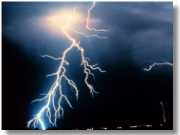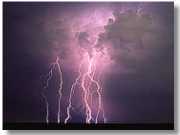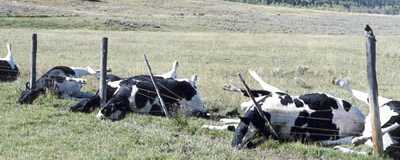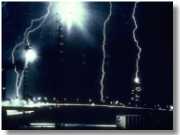
 Thunder and Lightning
Thunder and Lightning
Every day, hundreds of storms send bolts of lightning shooting across the sky and to the ground with loud claps of thunder. Most of the time, this static electricity on steroids doesn't cause problems and no protection is required, but occasionally it will hit just the right spot at just the right time to cause a power outage or injuries. Luckily, lightning storms are easy to prepare for and usually fast to recover from, not like a flood or earthquake, but still lightning kills more people annually than any other weather activity. Increased education and safety precautions are helping drop the average killed per year in the U.S. but it is still between 65 and 80 people annually.
Most frequent in spring and rare in winter, thunderstorms are possible at any time of the year and they generate over 25 million lightning strikes each year. Besides risks from lightning strikes, there may also be high winds, hail, and heavy rain that can damage property and cause injury. Severe thunderstorms also mean a possibility of tornado activity. A Storm Watch indicates conditions are ideal for the formation of a lightning storm while a Storm Warning means a storm has in fact been sighted and actions should be taken to ensure lightning safety.
 Seek Shelter
Seek Shelter
Very rarely, a lightning bolt may travel many miles from an obvious storm cloud to strike an object on the ground. The closer the storm approaches, the higher the risk of lightning strikes. A general rule of thumb is to be in a sheltered location before there is less than 30 seconds between lightning flash and the sound of thunder. And, stay in shelter for at least 30 minutes after the last lightning strike in your area.
Sound travels about 1 mile in 5 seconds. Count the seconds from when you see a flash and then divide by 5 to get an estimate of the distance or use this calculator to determine how far away lightning really is:
 Lightning Safety Practices
Lightning Safety Practices
Common sense isn't as common as it used to be. Many people have lost respect for nature and the risks of living. By following a few guidelines for lightning protection, your chances of staying out of trouble go way up:
- Keep a weather radio with you during storm season, especially when participating in outdoor activities.
- Don't plan outdoor activities when storms are predicted - if you trust your weatherman :-)
- Be aware of the general weather patterns in your area and plan smart. For example, an evening outdoor wedding in June in Minnesota had better have an indoor back-up plan - it would be much better to plan it for noon.
- When camping, set up camp in or by a low grove of trees, preferably close to the floor of a valley. Stay off hilltops and avoid wide open fields so you do not act like a lightning rod. Your tent can keep you dry but that's all.
- Stay off water and away from water when storms approach.
If you have no safe buildings available, seek shelter in a vehicle. A hard-top car rather than a convertible. Roll up all the windows, close the doors, and do not touch anything metal. Do not use the radio or any other electronic devices until the storm is well past.
 Stuck Outside
Stuck Outside
There are no safe places outside in a lightning storm. But, there are quite a few things you can do to minimize your risk if you absolutely can not get to safety in time:
- Do not seek rain shelter under an isolated tree or two. You may stay dry but your chances of being struck by lightning go way up. Instead, get under a canopy of many trees.
- Hiding under a picnic tent, pavilion, or other open or temporary structures attracts lightning.
- Stay clear of tall, isolated objects such as power poles, antennaes, flagpoles.
- Stay away from metal objects. It's better to be in a raincoat under some trees well away from your backpack, tent poles, and cooking gear. Check out this photo by Ruth Lyon-Bateman from www.lightningsafety.noaa.gov of cows killed by lightning striking the barbed wire fence they were huddled against.

- As a last resort if you are somehow caught in the open and lightning is present, current wisdom recommends holding a crouch position as well as you can until the storm has passed.
- Have each person at least 50 feet apart to minimze group injuries
- Remove jewelry, watches, belt buckles, other metal items that may cause severe burns if you are struck
- Stand on a plastic sheet, sleeping pad, or such thing that will isolate you from the wet ground to minimize your conductivity
- Squat down, sitting on the heels of your feet with the balls and toes of your feet touching the ground to lower your height
- Keep your feet as close together as possible to minimize your footprint - strikes close to you will send out tendrils of electricity so the more ground contact you have, the greater your risk
- Tuck your head down to your knees to minimize chance of a strike on the head and give lightning that does hit you a path down your back to ground - your chances of survival are greater
- cover your ears to protect against hearing damage from close strikes
- close your eyes to minimize blindness from close strikes
- Try to hold this position for the hour that the storm takes to pass through - good luck!
- While golfing or at a sporting event:
- toss your clubs, bats, or other gear aside and get far away from them
- get away from your golf cart, do not sit in it while the rain passes
- get away from all metal objects and tall objects - goal posts, score boards, fences, bleachers, light poles, flag poles, baseball bats, ...
- While boating:
- If the boat has no cabin, get off the water as soon as skies become threatening
- Go below deck in a boat with a cabin
- Avoid all metal fixtures and objects
- Put away your fishing pole
- Stay out of the water
- Do not use the radio or other electronics
 If Lightning Strikes
If Lightning Strikes
Lightning does strike the ground hundreds of times every day. If it strikes you, your family, or home, what should you do?
- Attend to injured first
- Have a first aid kit ready. Spend time waiting out the storm to review possible injuries and how to treat them.
- It is ok to touch people immediately after they are struck by a bolt of lightning. It is not like someone in contact with an electrical wire.
- If anyone has no pulse, treat them first. By knowing proper CPR you have a chance of helping them recover since a stopped heart due to lightning is one of the higher success scenarios for CPR. See CPR Dude for more CPR information.
- Treat for bleeding, burns, broken bones, shock. Check around any jewelry and metal objects for hidden burns. See First Aid Dude for first aid information.
- Check for fire in your attic and other hidden spaces. Immediately after a strike, check your home. A fire can spread quickly and silently before your smoke alarms notice it. A lightning rod properly grounded gives the electric blast an easy path to earth but your home may still suffer damage.
- After the storm passes, check out all your electronics and home systems such as heating and air conditioning to ensure there was no damage.

Find Emergency and Disaster Info at www.EmergencyDude.com

